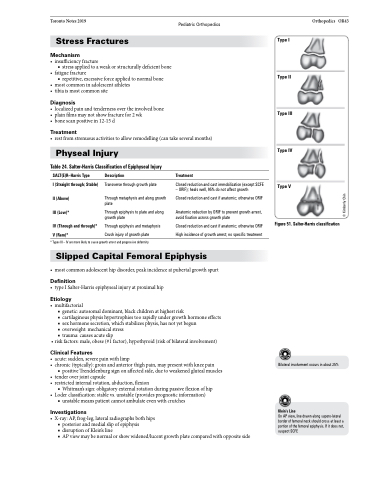Page 977 - TNFlipTest
P. 977
Toronto Notes 2019
Pediatric Orthopedics
Orthopedics OR43
Stress Fractures
Mechanism
• insufficiencyfracture
■ stress applied to a weak or structurally deficient bone
• fatiguefracture
■ repetitive, excessive force applied to normal bone
• mostcommoninadolescentathletes • tibiaismostcommonsite
Diagnosis
• localizedpainandtendernessovertheinvolvedbone • plainfilmsmaynotshowfracturefor2wk
• bonescanpositivein12-15d
Treatment
• restfromstrenuousactivitiestoallowremodelling(cantakeseveralmonths)
Type I
Physeal Injury
Table 24. Salter-Harris Classification of Epiphyseal Injury
Type II
Type III
Type IV
Type V
Figure 51. Salter-Harris classification
SALT(E)R–Harris Type
I (Straight through; Stable)
II (Above)
III (Low)*
IV (Through and through)* V (Ram)*
Description
Transverse through growth plate
Through metaphysis and along growth plate
Through epiphysis to plate and along growth plate
Through epiphysis and metaphysis Crush injury of growth plate
Treatment
Closed reduction and cast immobilization (except SCFE – ORIF); heals well, 95% do not affect growth
Closed reduction and cast if anatomic; otherwise ORIF
Anatomic reduction by ORIF to prevent growth arrest, avoid fixation across growth plate
Closed reduction and cast if anatomic; otherwise ORIF High incidence of growth arrest; no specific treatment
* Types III – IV are more likely to cause growth arrest and progressive deformity
Slipped Capital Femoral Epiphysis
• mostcommonadolescenthipdisorder,peakincidenceatpubertalgrowthspurt
Definition
• typeISalter-Harrisepiphysealinjuryatproximalhip
Etiology
• multifactorial
■ genetic: autosomal dominant, black children at highest risk
■ cartilaginous physis hypertrophies too rapidly under growth hormone effects ■ sex hormone secretion, which stabilizes physis, has not yet begun
■ overweight: mechanical stress
■ trauma: causes acute slip
• risk factors: male, obese (#1 factor), hypothyroid (risk of bilateral involvement)
Clinical Features
• acute:sudden,severepainwithlimp
• chronic(typically):groinandanteriorthighpain,maypresentwithkneepain
■ positive Trendelenburg sign on affected side, due to weakened gluteal muscles • tenderoverjointcapsule
• restrictedinternalrotation,abduction,flexion
■ Whitman’s sign: obligatory external rotation during passive flexion of hip • Loderclassification:stablevs.unstable(providesprognosticinformation)
■ unstable means patient cannot ambulate even with crutches
Investigations
• X-ray:AP,frog-leg,lateralradiographsbothhips
■ posterior and medial slip of epiphysis
■ disruptionofKlein’sline
■ AP view may be normal or show widened/lucent growth plate compared with opposite side
Bilateralinvolvementoccursinabout25%
Klein’s Line
On AP view, line drawn along supero-lateral border of femoral neck should cross at least a portion of the femoral epiphysis. If it does not, suspectSCFE
© Kimberly Chin


